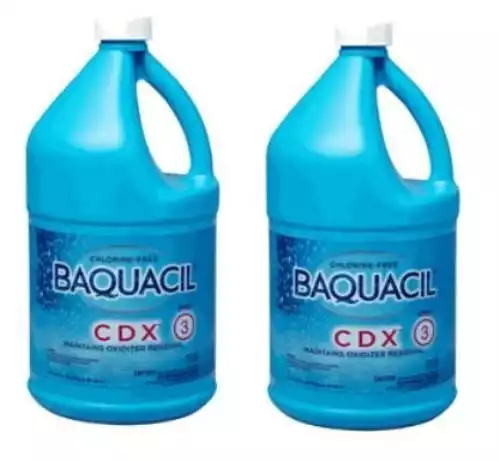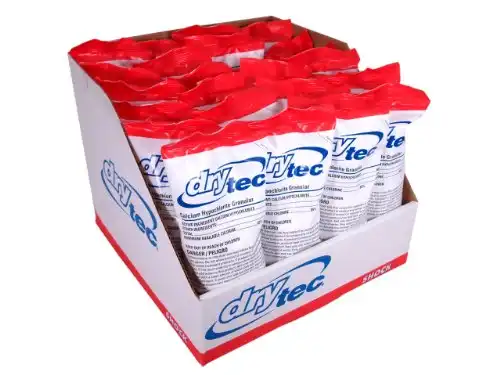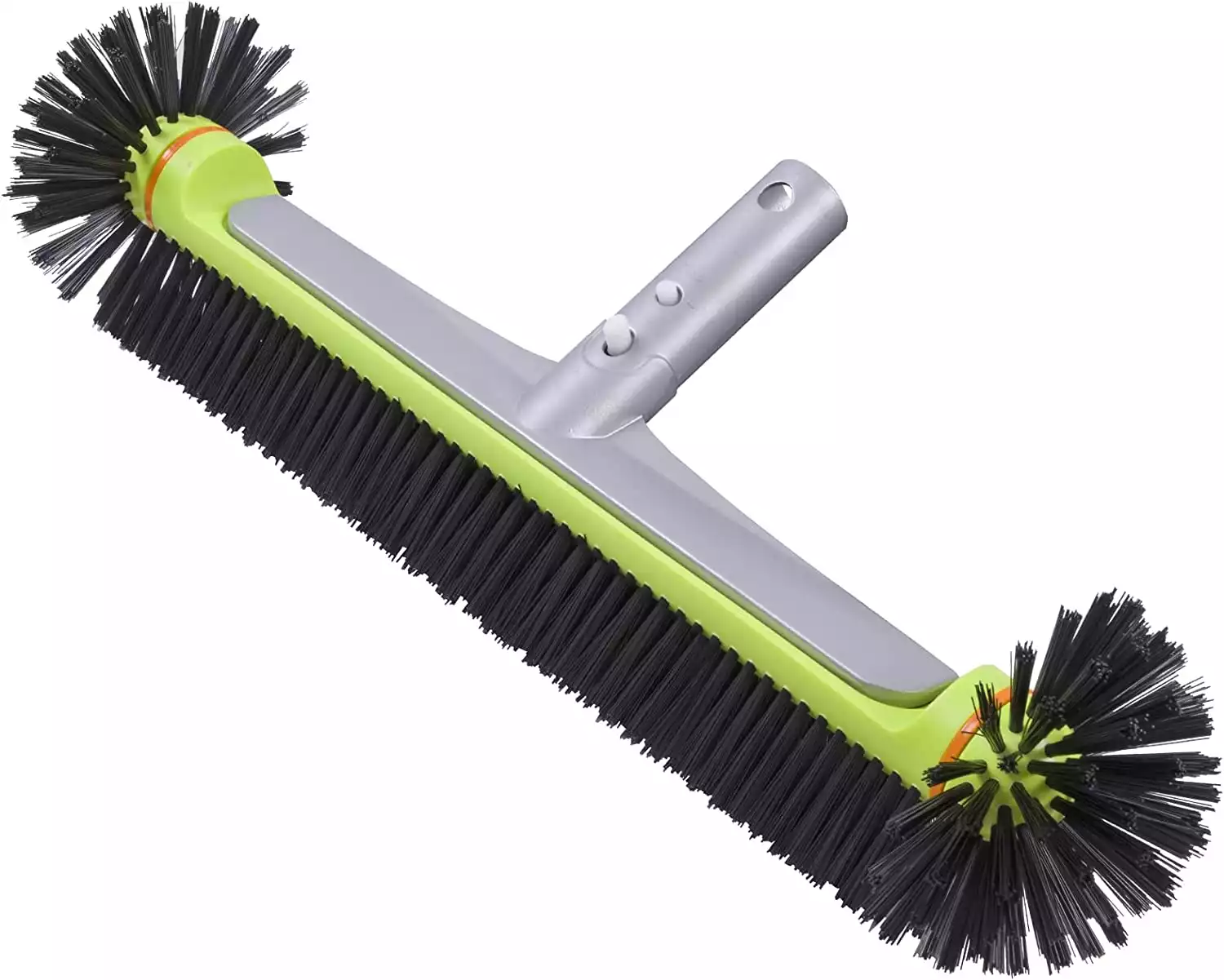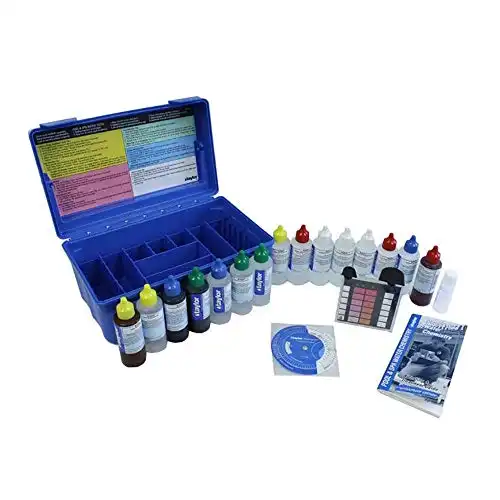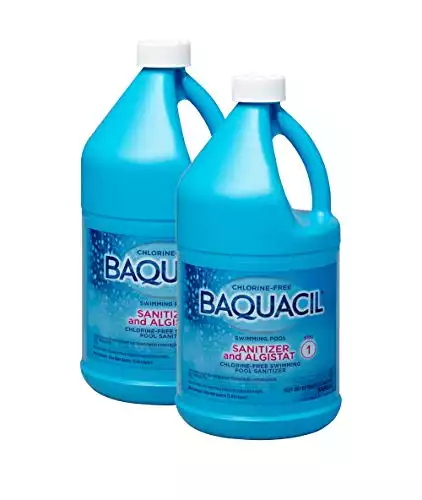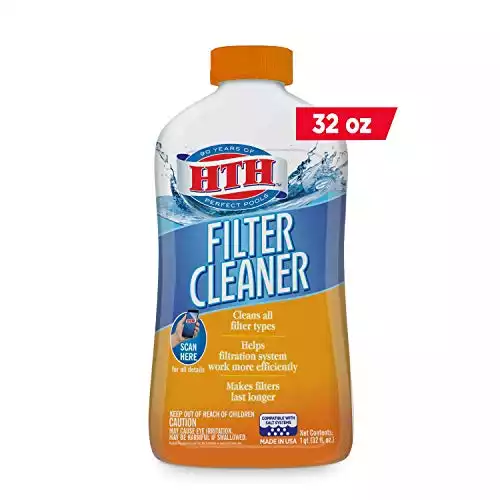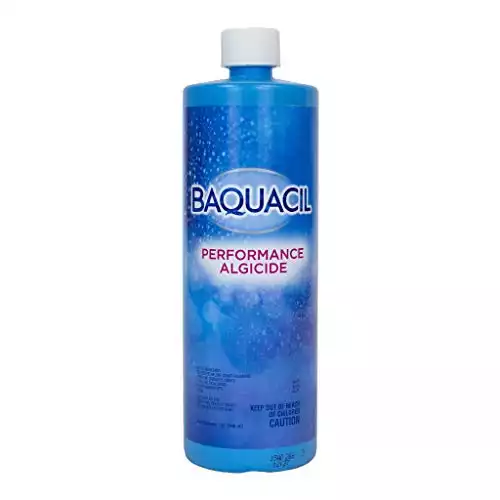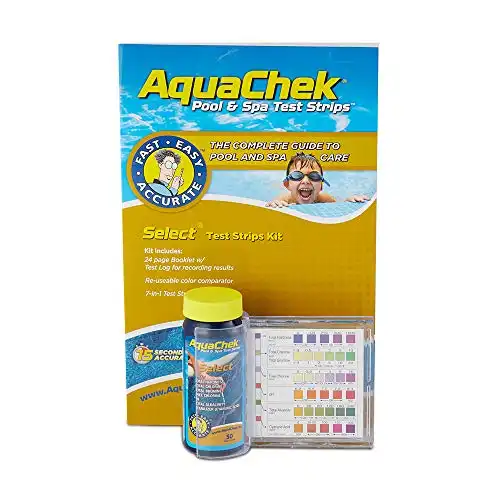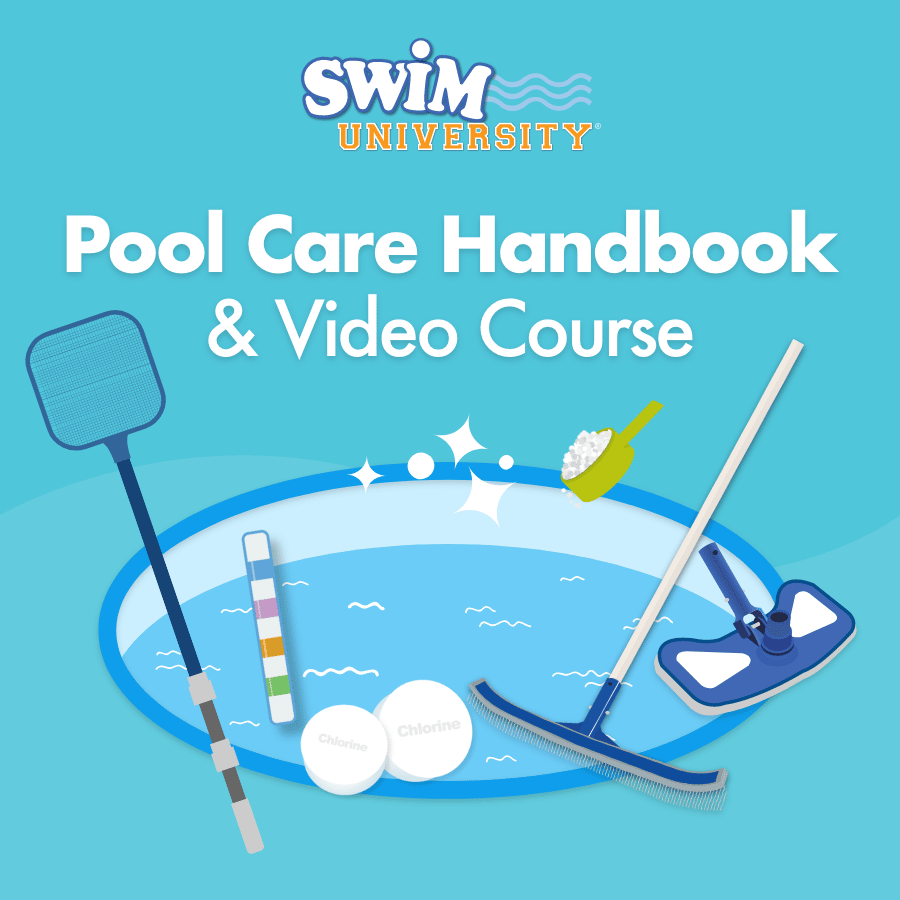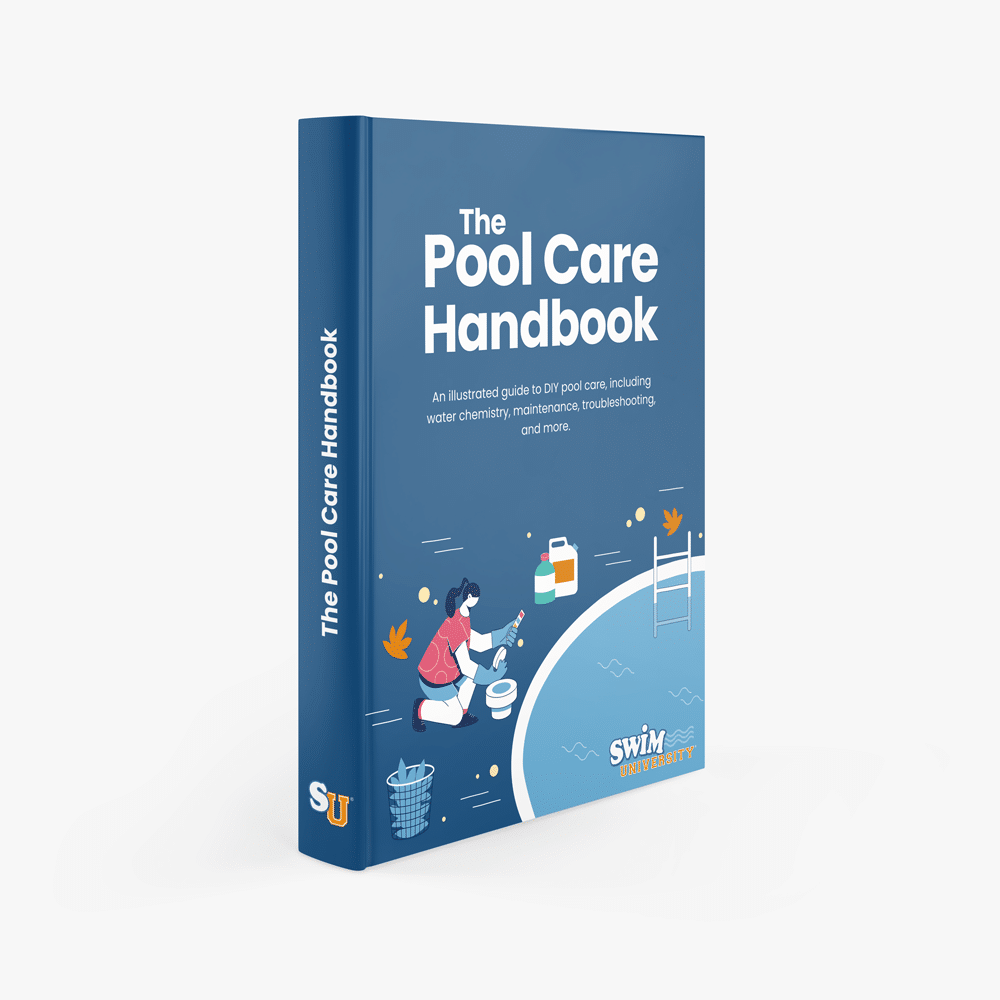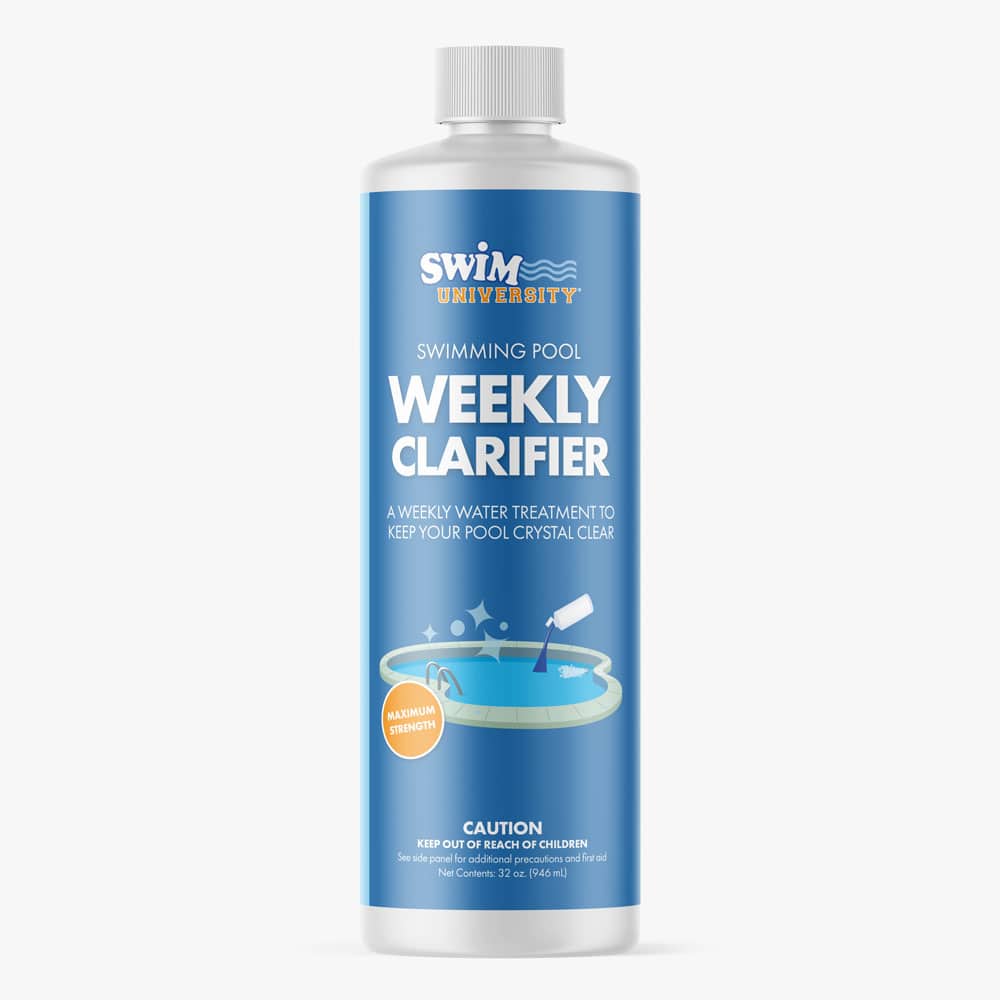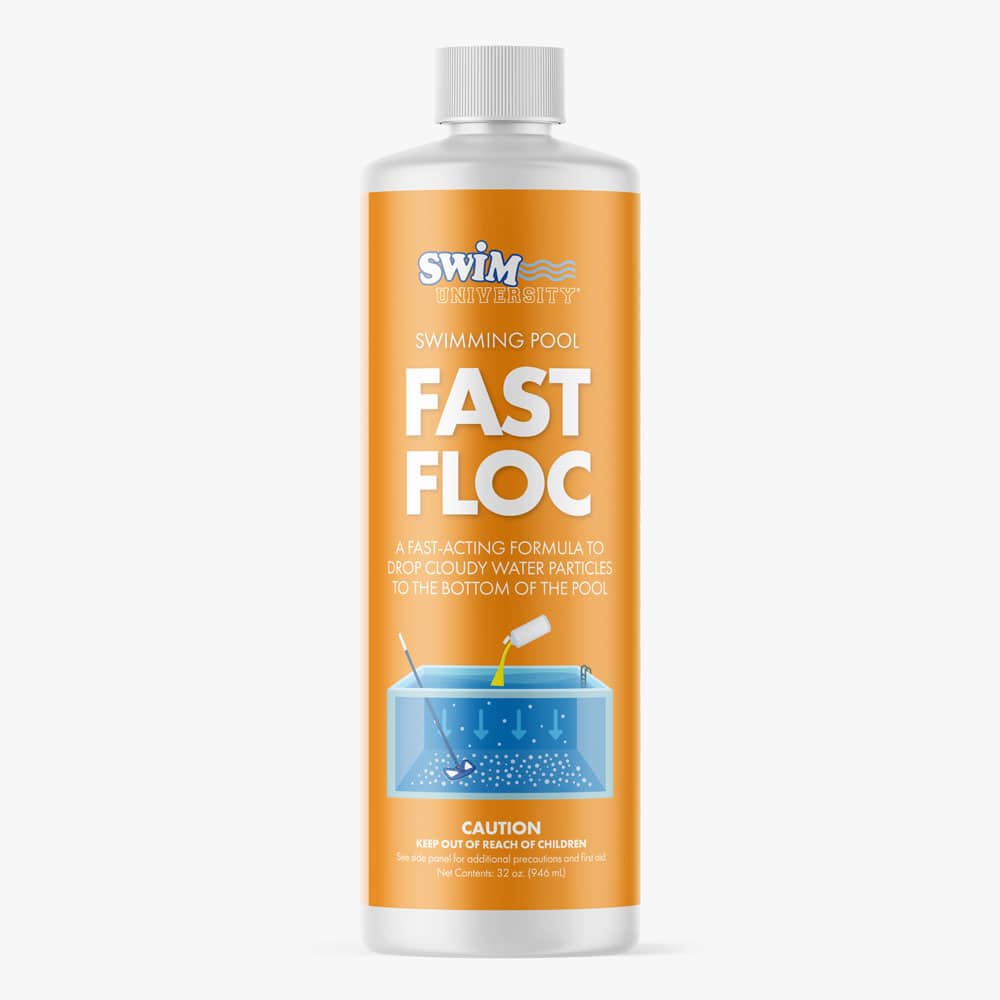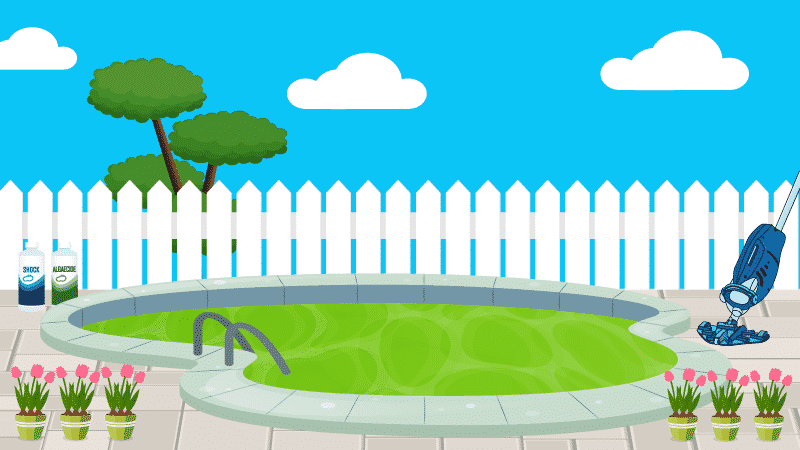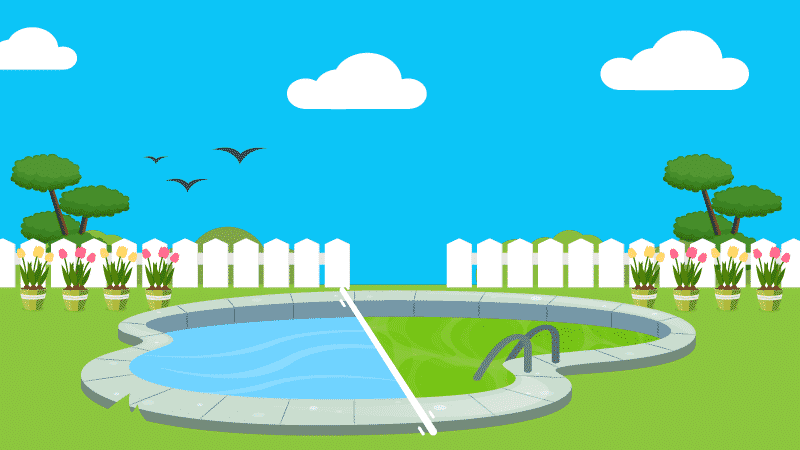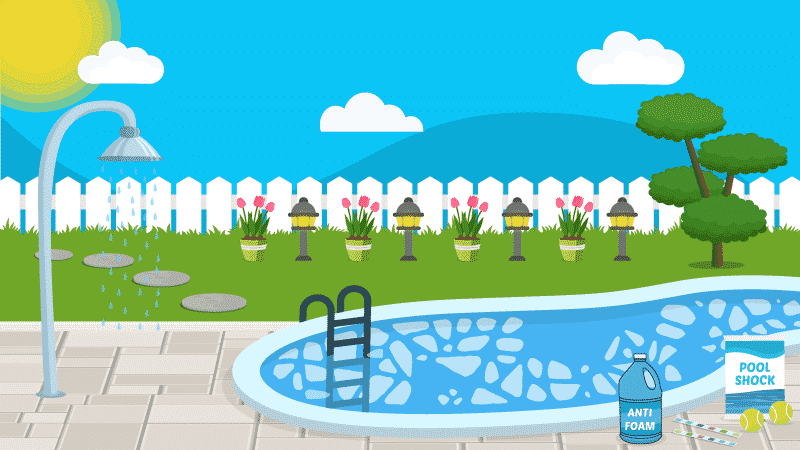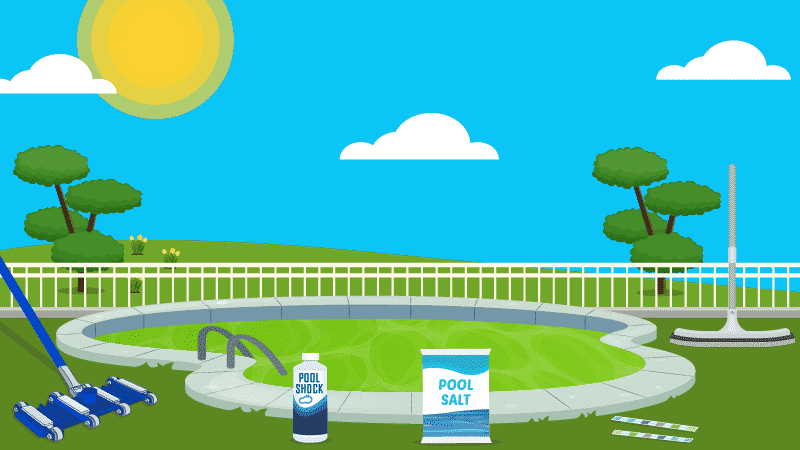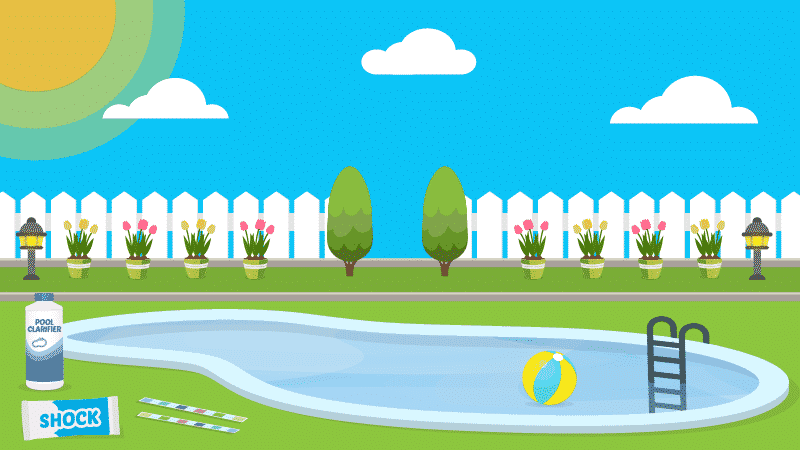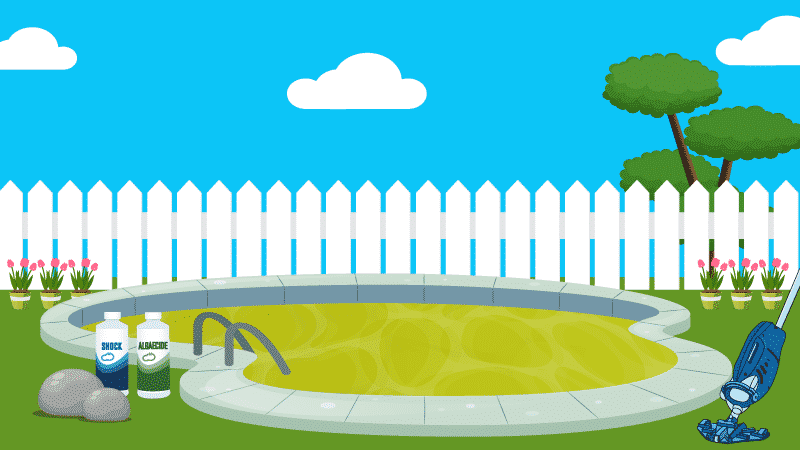Does it look like your pool has a nasty cold? Do you see something that looks like mucus floating in the water, and covering pool surfaces? Yup, you’ve got a white water mold problem.
Or maybe you’ve noticed orangeish-pink streaks or spots around your pool’s waterline, in the corners, on light fixtures and pipe fittings, or even on the water’s surface. You’re dealing with pink slime.
Fortunately, addressing both of these problems is as easy as preventing them from happening again in the future. All it takes is an understanding of what these substances truly are.
What Are White Water Mold and Pink Slime?
They’re two disgusting contaminants that may invade your pool from time to time. White water mold, like any mold, is a fungus. Pink slime, though sometimes mistaken for algae, is actually bacteria. The best treatment is prevention. Keep your pool clean and sanitized, and the water balanced.
What is White Water Mold?
Just like any other type of mold, white water mold is a type of fungus. All molds are fungi, but not all fungi are molds. For example, yeast is also a fungus, but it’s not mold, which is a good thing because without it, we wouldn’t have bread and beer. Then again, without mold, we wouldn’t have penicillin. Regardless, white water mold is not something you want in your pool.
What is That Pink Slime in a Pool?
Because of its appearance, you may have heard pink slime in a pool referred to as pink algae. But it’s not algae at all. It’s Serratia marcescens, also known as pink bacteria.
You’ve probably seen it before, in your home, most likely in your bathroom. Maybe along the bottom of your shower curtain, or around the water line in a toilet bowl. You may have heard some people say, “Oh, that’s just rust. We have hard water.”
It’s not rust. It’s an airborne bacteria that loves moist environments, especially bathrooms, because it feeds on the mineral deposits found in soap scum. It also likes fatty deposits found in soap and shampoo residue. Apparently, pink bacteria is not a picky eater.
Aside from being unsightly, it’s also dangerous. If the bacteria enters the body, usually through the eyes or nose, or via an open wound, it can cause numerous illnesses such as pneumonia, urinary tract infections, lower respiratory tract infections, to name just a few. For this reason, it’s all the more important to get rid of it when you find it in your pool, or better yet, keep it from occurring at all.
Important: Another place you may see pink bacteria in your home is in a pet’s water dish. If this happens, you must clean and sanitize the dish, and keep it clean to prevent illness. Serratia marcescens can cause or complicate urinary tract infections in dogs, and bacteremia in both dogs and cats.
What Causes White Water Mold and Pink Slime?
Just like any other type of fungus or bacteria, white water mold and pink slime are organic, naturally occurring substances.
If you find either one—or heaven forbid, both—in your pool, it’s due to two factors: your pool isn’t clean, and the water isn’t properly balanced.
Does Biguanide Cause White Water Mold?
No. This rumor persists for some reason, but no. Biguanide (which you may know under the brand name Baquacil) doesn’t cause white mold to grow in your pool.
In fact, biguanide can help get rid of it, if that’s the system you’re already using in your pool.
Whichever problem you have, the first step in getting rid of either mold or slime is going to be to clean your pool.
How to Get Rid of White Water Mold in a Chlorine Pool
It’s important to be thorough in this process because even the smallest bit of white water mold left behind can multiply and go right back to being a big problem in no time.
1. Clean the Filter
If there’s white water mold in your pool, it’s probably in your filter too. So before you do anything else, clean the filter because you’ll need to use the filter later on to complete this process. It won’t be as effective if it’s infested with mold.
For this step, simply backwashing a sand or D.E. filter, or spraying the cartridge with a hose is enough, though you can also use filter cleaner if you want to.
2. Balance the Water
The most important level to balance is the pH. Make sure it’s between 7.4 and 7.6, with 7.5 being ideal.
3. Shock the Pool
A regular dose won’t be enough to kill the white water mold. You’ll need to triple or even quadruple shock your pool with chlorine shock. That means adding 3 or 4 pounds of calcium hypochlorite shock per 10,000 gallons of water.
If you’re not sure of your pool’s volume, you can use a pool calculator to figure it out before shocking.
 Rectangle
Rectangle
 Round
Round
Important: Remember, you need to shock your pool at dusk or night, so plan this process accordingly.
This fast-acting, quick-dissolving swimming pool shock kills bacteria, controls algae, and destroys organic contaminants in pools.
4. Brush the Pool
Using a stiff pool brush, thoroughly brush the pool’s bottom and walls. The goal is to brush as much of the white water mold off the surface as possible.
Check in and around the skimmer and return jets, behind ladders, and in shady spots of your pool where mold likes to lurk.
The wide pool brush with 360-degree reach helps clean hard-to-reach surfaces and tough crevices. Perfect for any type of pool, including vinyl liners, fiberglass, and painted concrete.
5. Run the Pump
Overnight is good, but for 24 hours is even better. The idea is to get all the mold you brushed from the pool into the filter, so give it as much time as you can.
6. Brush the Pool Again
Think you got all the mold the first time around? Think again. You probably missed some, and if you leave it, everything you’re doing now will be for nothing because it’ll come right back.
So brush the sides and bottom of the pool again, and then let everything you brush up settle on the bottom.
7. Vacuum the Pool
An automatic pool cleaner won’t be enough for this job. You’ll need to manually vacuum the pool. Be sure to vacuum to waste.
Tip: Depending on how much mold and other debris you have to vacuum out of the pool, the water line may drop too low. Have a garden hose handy to refill as necessary.
8. Clean the Filter Again
This time, definitely use a filter cleaner for a sand or D.E. filter, or a chemical soak for a cartridge filter.
9. Test and Balance the Water
You can use test strips or a liquid test kit, or take a sample of pool water to your local pool store and have them test it for you. Make sure you bring the pH, alkalinity, and especially the chlorine back up to the right levels.
Note: Yes, you do need to repeat a couple of steps. That should be an indication of what a problem white water mold is, and how difficult it can be to get rid of it. Be patient and thorough, because repeating a couple of steps is better than repeating the entire process if any mold is left behind.
A simple but effective liquid test kit for chlorine pools and hot tubs.
Keep an Eye Out for More Mold
You’ll want to closely monitor your pool for a few days to a week after this cleaning process to make sure the white water mold doesn’t return.
During that time, run the pump as often and for as long as you can. Also, brush and vacuum the pool every other day, just to be sure.
How to Get Rid of White Water Mold in a Biguanide Pool
This process will be very similar to the one for a chlorine pool, just with different chemicals and a couple of slight adjustments.
1. Clean the Filter
If there’s white water mold in your pool, it’s probably in your filter too. So before you do anything else, clean the pool filter because you’ll need to use the filter later on to complete this process. It won’t be as effective if it’s infested with mold.
For this step, simply backwashing a sand or D.E. filter, or spraying the cartridge with a hose is enough, though you can also use filter cleaner if you want to.
2. Balance the Water
The most important level to balance is the pH. Make sure it’s between 7.4 and 7.6, with 7.5 being ideal.
3. Use an Oxidizer
Remember, biguanide sanitizer doesn’t oxidize contaminants, so you must supplement it with an oxidizer. Also, you can’t use regular shock—chlorine or non-chlorine—in a biguanide pool.
A regular dose won’t be enough to kill the white water mold. You’ll need to use a triple or even quadruple dose. That means adding 3 or 4 gallons of oxidizer per 10,000 gallons of water.
4. Brush the Pool
Using a stiff pool brush, thoroughly brush the pool’s bottom and walls. The goal is to brush as much of the white water mold off the surface as possible.
Check in and around the skimmer and return jets, behind ladders, and in shady spots of your pool where mold likes to lurk.
5. Run the Pump
Overnight is good, but for 24 hours is even better. The idea is to get all the mold you brushed from the pool into the filter, so give it as much time as you can.
6. Brush the Pool Again
Think you got all the mold the first time around? Think again. You probably missed some, and if you leave it, everything you’re doing now will be for nothing because it’ll come right back.
So brush the sides and bottom of the pool again, and then let everything you brush up settle on the bottom.
7. Vacuum the Pool
An automatic pool cleaner won’t be enough for this job. You’ll need to manually vacuum the pool. Be sure to vacuum to waste.
Tip: Depending on how much mold and other debris you have to vacuum out of the pool, the water line may drop too low. Have a garden hose handy to refill as necessary.
8. Clean the Filter Again
This time, definitely use a filter cleaner for a sand or D.E. filter, or a chemical soak for a cartridge filter.
Spray or soak your pool filter in this powerful cleaner to make your filter perform like new!
9. Test and Balance the Water
You can use test strips or a liquid test kit, or take a sample of pool water to your local pool store and have them test it for you. Make sure you bring the pH, alkalinity, and especially the chlorine back up to the right levels.
10. Add Algaecide
Important: You won’t do this step until 5 to 7 days after completing the cleaning process.
We don’t normally recommend using algaecide. But a biguanide algaecide does more than fight algae. It also works with the sanitizer and oxidizer to kill and prevent white water mold.
Add 4 ounces of biguanide algaecide for every 10,000 gallons of water in your pool. You can continue to do this once a week for regular maintenance, if you like.
Note: Yes, you do need to repeat a couple of steps. That should be an indication of what a problem white water mold is, and how difficult it can be to get rid of it. Be patient and thorough, because repeating a couple of steps is better than repeating the entire process if any mold is left behind.
Keep an Eye Out for More Mold
You’ll want to closely monitor your pool for a few days to a week after this cleaning process to make sure the white water mold doesn’t return.
During that time, run the pump as often and for as long as you can. Also, brush and vacuum the pool every other day, just to be sure.
Cut the confusion with our easy-to-use video course. Save $1,000's on pool care and keep your water clean and clear for good!
Learn MoreHow to Get Rid of Pink Slime in a Chlorine Pool
Unfortunately, pink bacteria is resistant to most of the chemicals you use to clean and sanitize your pool, even chlorine. So the usual cleaning processes and sanitizer doses just won’t do.
1. Clean the Filter
If there’s pink bacteria in your pool, it’s probably in your filter too. So before you do anything else, clean the pool filter because you’ll need to use the filter later on to complete this process.
For this step, simply backwashing a sand or D.E. filter, or spraying the cartridge with a hose is enough, though you can also use filter cleaner if you want to.
2. Balance the Water
The most important level to balance is the pH. Make sure it’s between 7.4 and 7.6, with 7.5 being ideal.
3. Turn off the Pump
You’ll be adding some chemicals to the water, and you don’t want them to circulate just yet.
4. Brush the Pool
Using a stiff pool brush, thoroughly brush the pool’s bottom and walls. The goal is to brush as much of the pink bacteria off the surface as possible.
Check in and around the skimmer and return jets, behind ladders, and in shady spots of your pool where bacteria likes to lurk.
5. Add Algaecide (Sort Of)
We’ve already established that pink slime is bacteria and not algae. Yet, because so many people refer to it as pink algae, some companies have created products to address the problem as it’s popularly known.
So look for an “algaecide” that specifies it’s for treating pink slim or pink bacteria. One such brand is Pink Treat.
Follow the manufacturer’s instructions on the package to add the appropriate amount for your pool’s volume.
6. Shock the Pool
A regular dose won’t be enough to kill the chemical-resistant pink bacteria. You’ll need to triple or even quadruple shock your pool with chlorine shock. That means adding 3 or 4 pounds of calcium hypochlorite shock per 10,000 gallons of water.
Test the water between each application of shock. The goal is to bring the chlorine level up to 5 parts per million (ppm).
Important: Remember, you need to shock your pool at dusk or night, so plan this process accordingly.
7. Take a Break
With the pump still off, let the pool sit overnight.
8. Vacuum the Pool
An automatic pool cleaner won’t be enough for this job. You’ll need to manually vacuum the pool. Be sure to vacuum to waste.
Tip: Don’t allow the water line to drop too low. Have a garden hose handy to refill as necessary.
9. Clean the Filter Again
This time, definitely use a filter cleaner for a sand or D.E. filter, or a chemical soak for a cartridge filter.
10. Run the Pump
Keep it on as you normally would.
11. Keep the Chlorine Level High
For about a week after this treatment, keep the chlorine level at 5 ppm. You’ll need to test the water every day to ensure you’re maintaining this level.
The easiest way to test that often is with test strips or a liquid test kit.
Tests for 7 important chemistries in seconds: Total Hardness, Total Chlorine, Total Bromine, Free Chlorine, pH, Total Alkalinity, and Cyanuric Acid.
12. Balance the Water
After a week, allow the chlorine level to drop back to normal, then balance the water as you normally do, bringing all levels to where they should be.
How to Get Rid of Pink Slime in a Biguanide Pool
This process will be very similar to the one for a chlorine pool, just with different chemicals and a couple of slight adjustments.
1. Clean the Filter
If there’s pink bacteria in your pool, it’s probably in your filter too. So before you do anything else, clean the pool filter because you’ll need to use the filter later on to complete this process.
For this step, simply backwashing a sand or D.E. filter, or spraying the cartridge with a hose is enough, though you can also use filter cleaner if you want to.
2. Balance the Water
The most important level to balance is the pH. Make sure it’s between 7.4 and 7.6, with 7.5 being ideal.
3. Turn off the Pump
You’ll be adding some chemicals to the water, and you don’t want them to circulate just yet.
4. Brush the Pool
Using a stiff pool brush, thoroughly brush the pool’s bottom and walls. The goal is to brush as much of the pink bacteria off the surface as possible.
Check in and around the skimmer and return jets, behind ladders, and in shady spots of your pool where bacteria likes to lurk.
Add Biguanide Algaecide
Remember, you cannot use regular algaecide—or the pink-specific “algaecide”—in a biguanide pool. Add 16 ounces of biguanide algaecide for every 10,000 gallons of pool water.
3. Add an Oxidizer
Remember, biguanide sanitizer doesn’t oxidize contaminants, so you must supplement it with an oxidizer. Also, you can’t use regular shock—chlorine or non-chlorine—in a biguanide pool.
A regular dose won’t be enough to kill the chemical-resistant pink bacteria. You’ll need to use a triple or even quadruple dose. That means adding 3 or 4 gallons of oxidizer per 10,000 gallons of water.
4. Raise the Sanitizer Level
The usual range for biguanide is 30 ppm to 50 ppm. To kill the pink bacteria, bring the biguanide level up to 50 ppm.
6. Take a Break
With the pump still off, let the pool sit overnight.
7. Vacuum the Pool
An automatic pool cleaner won’t be enough for this job. You’ll need to manually vacuum the pool. Be sure to vacuum to waste.
Tip: Don’t allow the water line to drop too low. Have a garden hose handy to refill as necessary.
Recheck the Sanitizer Level
Make sure the biguanide level is still at 50 ppm. If it’s fallen, add more biguanide to bring it back up.
8. Clean the Filter Again
This time, definitely use a filter cleaner for a sand or D.E. filter, or a chemical soak for a cartridge filter.
9. Run the Pump
Keep it running continuously until the water clears.
11. Balance the Water
Once the water clears, allow the biguanide level to drop back to within the normal range, then balance the water as you normally do, bringing all levels to where they should be.
Keep an Eye Out for More Bacteria
You’ll want to closely monitor your pool for a few days to a week after this cleaning process to make sure the pink bacteria doesn’t return.
During that time, run the pump as often and for as long as you can. Also, brush and vacuum the pool every other day, just to be sure.
How to Prevent White Water Mold and Pink Slime in Your Pool
Whew! After all that work, you’ll want to make sure you keep that mold and bacteria where it belongs—out of your pool!
The best ways to prevent either invasion are to keep your pool clean (and we mean clean), keep the water balanced (especially the pH and sanitizer levels), and shock regularly (or use an oxidizer for a biguanide pool).
No More Pink, White and Blue for You!
Just when you thought it was safe to go back into the water—it is! After putting in all that hard work, you deserve to enjoy your pool. Just stick to your pool care schedule to keep that white water mold away, and don’t allow the pink slime back in your pool. A little maintenance goes a long way to keeping your pool clean, clear, and swimmable.
Happy Swimming!
Need More Pool Maintenance Help?
- Download our free Pool Care Cheat Sheet. It’s a free, easy-to-use guide to help you keep track of taking care of your pool.
- Subscribe to our Swim University YouTube Channel. We publish free video tutorials throughout the pool season.
- Check out our Pool Care Course. You’ll get 30+ step-by-step videos and a downloadable guide with everything you need to know about pool maintenance.


